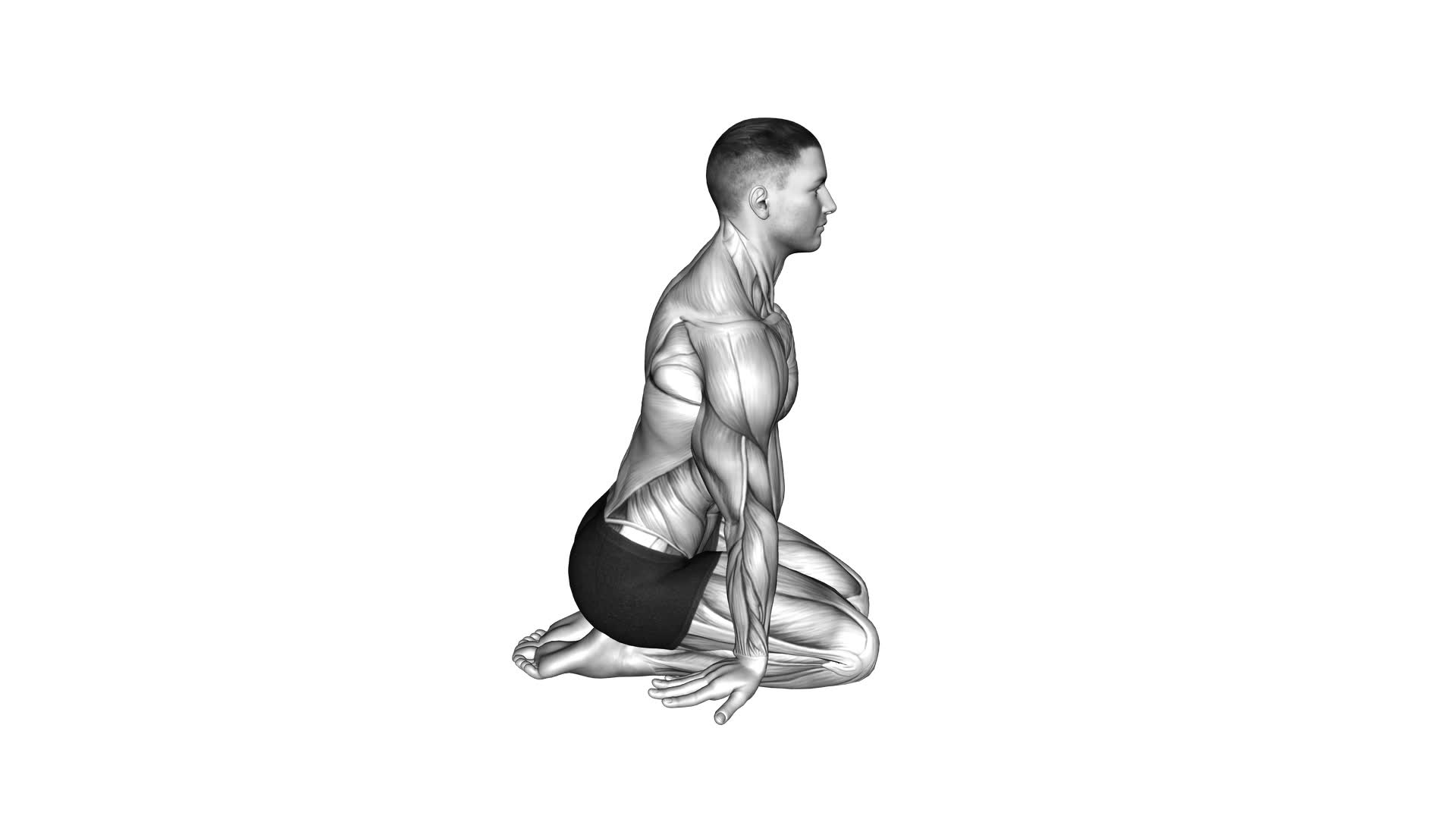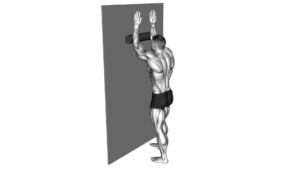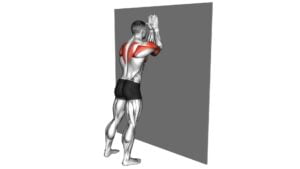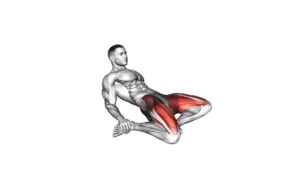Seated Forearms Stretch (male) – Video Exercise Guide & Tips

Incorporate the seated forearms stretch into your routine for increased flexibility and improved wrist mobility. This video exercise guide provides step-by-step instructions and helpful tips to ensure proper form and technique.
Watch This Exercise Video
Discover the benefits of this stretch, including relief from tightness and tension in the forearms. Avoid common mistakes and maximize the stretch with expert guidance.
Whether you're a beginner or advanced fitness enthusiast, there are modifications available to suit your fitness level.
Get ready to enhance your upper body flexibility with this effective stretch.
Key Takeaways
- The seated forearms stretch increases flexibility in the forearms.
- It reduces muscle tension in the arms.
- The stretch enhances overall athletic performance.
- It decreases the risk of injury and improves range of motion in the hands and wrists.
Benefits of the Seated Forearms Stretch
Experience the benefits of the Seated Forearms Stretch as you increase flexibility and reduce tension in your arms. This stretch specifically targets the muscles in your forearms, helping to improve flexibility and reduce muscle tension. By incorporating this stretch into your routine, you can enhance your overall athletic performance and decrease the risk of injury.
Improved flexibility is one of the key benefits of the Seated Forearms Stretch. As you stretch the muscles in your forearms, you increase their range of motion, allowing for greater flexibility and ease of movement. This can be particularly beneficial for activities that require repetitive motions of the hands and wrists, such as typing or playing a musical instrument.
Additionally, the Seated Forearms Stretch helps to reduce muscle tension in the arms. Tension in the forearms can lead to discomfort and even pain, especially for those who engage in activities that require gripping or repetitive hand movements. By stretching these muscles, you can release tension and promote relaxation in the arms.
As we move forward into the subsequent section about proper form and technique, it's important to remember that performing the Seated Forearms Stretch correctly will maximize its benefits and minimize the risk of injury.
Proper Form and Technique
To perform the Seated Forearms Stretch correctly, you need to maintain proper form and technique. This won't only ensure that you target the right muscles, but also help in improving flexibility and preventing injuries. Here are three key points to keep in mind:
- Sit upright on a chair with your feet flat on the floor and your back straight. This will help maintain proper alignment and prevent strain on your back.
- Extend your arms straight in front of you, parallel to the ground. Keep your palms facing down.
- Slowly rotate your palms upwards, while keeping your arms straight. You should feel a gentle stretch in your forearms. Hold this position for 15-30 seconds.
Maintaining proper form and technique is essential to maximize the benefits of the Seated Forearms Stretch. By stretching the muscles in your forearms, you can improve flexibility and reduce the risk of injuries.
Now, let's explore modifications for different fitness levels.
Modifications for Different Fitness Levels
To modify the Seated Forearms Stretch for different fitness levels, you can adjust the intensity of the stretch by altering the range of motion. For advanced practitioners looking to progress in their forearm flexibility, you can increase the range of motion by pushing your hands further away from your body during the stretch. This will provide a deeper and more intense stretch in the forearms. Additionally, you can also incorporate resistance by using a towel or resistance band to create more tension in the muscles.
On the other hand, for individuals with limited mobility or those who are just starting out, you can adapt the stretch to suit their needs. One option is to decrease the range of motion by keeping your hands closer to your body. This will still provide a gentle stretch without putting too much strain on the muscles.
Another modification is to perform the stretch while sitting on a chair instead of the floor. This will provide more stability and support for those who may have difficulty getting down to the floor.
Common Mistakes to Avoid
To ensure proper execution of the Seated Forearms Stretch, it's important to avoid common mistakes that may hinder your progress. By avoiding these mistakes, you can maximize the effectiveness of the stretch and minimize the risk of injury.
Here are three common mistakes to avoid:
- Poor body alignment: Proper alignment is crucial to avoid straining your muscles or joints. Make sure to sit up straight with your back against the chair and keep your feet flat on the ground. Avoid slouching or leaning forward as it can put unnecessary stress on your spine and wrists.
- Overstretching: While it's important to stretch your forearms, overstretching can lead to strain or injury. Gradually increase the intensity of the stretch and listen to your body's limits. If you feel any pain or discomfort, ease off the stretch and adjust accordingly.
- Neglecting breath control: Breathing plays a vital role in stretching exercises. Take slow, deep breaths and exhale as you stretch your forearms. This helps relax your muscles and allows for a deeper stretch. Avoid holding your breath or breathing shallowly as it can increase tension and limit the effectiveness of the stretch.
Tips for Maximizing the Stretch
Maximize the stretch by incorporating proper form and utilizing a resistance band. To maximize flexibility and improve grip strength during the seated forearms stretch, it's important to follow these tips.
Firstly, ensure that you're sitting upright with your feet flat on the floor and your back straight. This will help maintain proper alignment and prevent any unnecessary strain on your muscles. Next, position your arms parallel to the floor, with your palms facing down. This will target the flexor muscles in your forearms, allowing for a deeper stretch.
To further enhance the stretch, consider incorporating a resistance band. Place one end of the band around your fingers and the other end around a stationary object, such as a door handle or a sturdy piece of furniture. As you pull against the resistance of the band, you'll engage your forearm muscles even more, increasing the intensity of the stretch.
Remember to breathe deeply throughout the stretch, as deep breathing helps relax the muscles and allows for a greater range of motion. Additionally, try to hold the stretch for at least 30 seconds, gradually increasing the duration over time.
Incorporating the Seated Forearms Stretch Into Your Routine
To incorporate the seated forearms stretch into your routine, consider performing it before or after activities that involve gripping or using your hands extensively. This will help to warm up your forearms and increase flexibility, reducing the risk of injury and improving overall performance. Here are some tips to help you make the most out of this stretch:
- Seated Forearms Stretch Modifications:
- If you have limited mobility in your wrists, try using a towel or resistance band to assist with the stretch. Wrap it around your hands and gently pull to increase the intensity.
- For a deeper stretch, you can also perform the seated forearms stretch while kneeling on the ground. This will allow for a greater range of motion and increased tension in the forearms.
- Seated Forearms Stretch Variations:
- To target different areas of the forearms, you can experiment with different hand positions. For example, you can rotate your palms facing up or down to stretch different muscle groups.
- Another variation is to perform the stretch with your elbows bent at a 90-degree angle. This will target the muscles on the inside of your forearm.
- Frequency and Duration:
- Aim to perform the seated forearms stretch at least 2-3 times per week to maintain flexibility and prevent tightness.
- Hold each stretch for 15-30 seconds and repeat 2-3 times on each side.
Incorporating the seated forearms stretch into your routine can provide numerous benefits for your hand and forearm health. By following these modifications and variations, you can customize the stretch to suit your individual needs and goals.
Frequently Asked Questions
How Long Should I Hold the Seated Forearms Stretch?
When it comes to the seated forearms stretch, it's important to consider how long you should hold the stretch. The optimal duration for this stretch is typically around 30 seconds to 1 minute. Holding the stretch for this amount of time allows your muscles to fully relax and lengthen, increasing flexibility and reducing muscle tension.
Incorporating the seated forearms stretch into your daily routine can have numerous benefits, such as improved grip strength and decreased risk of forearm injuries.
Can I Do the Seated Forearms Stretch if I Have a Wrist Injury?
If you have a wrist injury, it's important to modify your forearm stretches to avoid further damage. The seated forearms stretch may not be suitable for you in this case.
However, there are alternative stretches that can provide similar benefits without putting too much strain on your wrists.
Consult with a healthcare professional or a physical therapist for guidance on modified forearm stretches and alternative exercises that will help you heal and strengthen your wrists safely.
Is It Better to Do the Seated Forearms Stretch Before or After a Workout?
When it comes to the seated forearms stretch, you might be wondering if it's better to do it before or after your workout. Well, let's break it down for you.
Doing the stretch before your workout can help warm up your forearms, increase flexibility, and prevent injury.
On the other hand, doing it after your workout can help cool down your muscles, improve recovery, and reduce soreness.
Can I Perform the Seated Forearms Stretch Without Any Equipment?
Yes, you can perform the seated forearms stretch without any equipment. This stretch targets the muscles in your forearms and can help improve flexibility and reduce muscle tension.
To perform the stretch, sit in a comfortable position with your spine straight. Extend one arm in front of you, palm facing up. Use your other hand to gently pull back on your fingers, feeling a stretch in your forearm.
Hold for 15-30 seconds and then switch arms.
Are There Any Variations of the Seated Forearms Stretch That I Can Try?
There are several variations of the seated forearms stretch that you can try. These variations can help target different muscles and increase the effectiveness of the stretch.
Some variations include using a towel or resistance band to enhance the stretch, or changing the angle of your wrists for a different stretch sensation.
Trying different variations can help you find the one that works best for you and maximize the benefits of the seated forearms stretch.
Conclusion
In conclusion, the seated forearms stretch is a beneficial exercise for improving flexibility and relieving tension in the forearms.
By following proper form and technique, individuals can maximize the effectiveness of this stretch.
Modifications can be made to accommodate different fitness levels, and it's important to avoid common mistakes to prevent injury.
Incorporating the seated forearms stretch into your routine can help enhance overall flexibility and promote better performance in various activities.

Author
Years ago, the spark of my life’s passion ignited in my mind the moment I stepped into the local gym for the first time. The inaugural bead of perspiration, the initial endeavor, the very first surge of endorphins, and a sense of pride that washed over me post-workout marked the beginning of my deep-seated interest in strength sports, fitness, and sports nutrition. This very curiosity blossomed rapidly into a profound fascination, propelling me to earn a Master’s degree in Physical Education from the Academy of Physical Education in Krakow, followed by a Sports Manager diploma from the Jagiellonian University. My journey of growth led me to gain more specialized qualifications, such as being a certified personal trainer with a focus on sports dietetics, a lifeguard, and an instructor for wellness and corrective gymnastics. Theoretical knowledge paired seamlessly with practical experience, reinforcing my belief that the transformation of individuals under my guidance was also a reflection of my personal growth. This belief holds true even today. Each day, I strive to push the boundaries and explore new realms. These realms gently elevate me to greater heights. The unique combination of passion for my field and the continuous quest for growth fuels my drive to break new ground.







